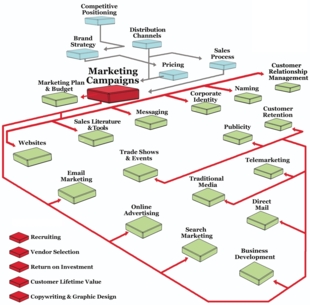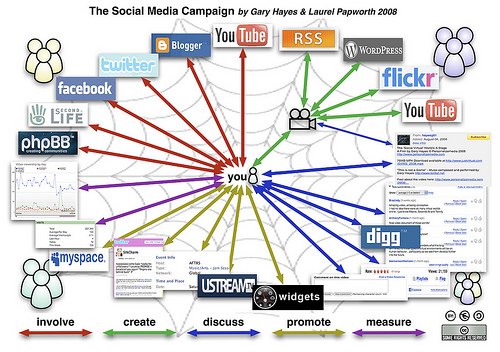Marketing Campaign Biography
While marketing mix models provide much useful information, there are two key areas in which these models have limitations that should be taken into account by all of those that use these models for decisionmaking purposes. These limitations, discussed more fully below, include:
1) the focus on short-term sales can significantly under-value the importance of longer-term equity building activities; and
2) when used for media mix optimization, these models have a clear bias in favor of time-specific media (such as TV commercials) versus less time-specific media (such as ads appearing in monthly magazines); biases can also occur when comparing broad-based media versus regionally or demographically targeted media.
In relation to the bias against equity building activities, marketing budgets optimized using marketing-mix models may tend too much towards efficiency because marketing-mix models measure only the short-term effects of marketing. Longer term effects of marketing are reflected in its brand equity. The impact of marketing spend on [brand equity] is usually not captured by marketing-mix models. One reason is that the longer duration that marketing takes to impact brand perception extends beyond the simultaneous or, at best, weeks-ahead impact of marketing on sales that these models measure. The other reason is that temporary fluctuation in sales due to economic and social conditions do not necessarily mean that marketing has been ineffective in building brand equity. On the contrary, it is very possible that in the short term sales and market-share could deteriorate, but brand equity could actually be higher. This higher equity should in the long run help the brand recover sales and market-share.
Because marketing-mix models suggest a marketing tactic has a positive impact on sales doesn't necessarily mean it has a positive impact on long-term brand equity. Different marketing measures impact short-term and long-term brand sales differently and adjusting the marketing portfolio to maximize either the short-term or the long-term alone will be sub-optimal. For example the short-term positive effect of promotions on consumers’ utility induces consumers to switch to the promoted brand, but the adverse impact of promotions on brand equity carries over from period to period. Therefore the net effect of promotions on a brand’s market share and profitability can be negative due to their adverse impact on brand. Determining marketing ROI on the basis of marketing-mix models alone can lead to misleading results. This is because marketing-mix attempts to optimize marketing-mix to increase incremental contribution, but marketing-mix also drives brand-equity, which is not part of the incremental part measured by marketing-mix model- it is part of the baseline. True 'Return on Marketing Investment' is a sum of short-term and long-term ROI. The fact that most firms use marketing-mix models only to measure the short-term ROI can be inferred from an article by Booz Allen Hamilton, which suggests that there is a significant shift away from traditional media to 'below-the-line' spending, driven by the fact that promotional spending is easier to measure. But academic studies have shown that promotional activities are in fact detrimental to long-term marketing ROI (Ataman et al., 2006). Short-term marketing-mix models can be combined with brand-equity models using brand-tracking data to measure 'brand ROI', in both the short- and long-term.
While marketing mix models provide much useful information, there are two key areas in which these models have limitations that should be taken into account by all of those that use these models for decisionmaking purposes. These limitations, discussed more fully below, include:
1) the focus on short-term sales can significantly under-value the importance of longer-term equity building activities; and
2) when used for media mix optimization, these models have a clear bias in favor of time-specific media (such as TV commercials) versus less time-specific media (such as ads appearing in monthly magazines); biases can also occur when comparing broad-based media versus regionally or demographically targeted media.
In relation to the bias against equity building activities, marketing budgets optimized using marketing-mix models may tend too much towards efficiency because marketing-mix models measure only the short-term effects of marketing. Longer term effects of marketing are reflected in its brand equity. The impact of marketing spend on [brand equity] is usually not captured by marketing-mix models. One reason is that the longer duration that marketing takes to impact brand perception extends beyond the simultaneous or, at best, weeks-ahead impact of marketing on sales that these models measure. The other reason is that temporary fluctuation in sales due to economic and social conditions do not necessarily mean that marketing has been ineffective in building brand equity. On the contrary, it is very possible that in the short term sales and market-share could deteriorate, but brand equity could actually be higher. This higher equity should in the long run help the brand recover sales and market-share.
Because marketing-mix models suggest a marketing tactic has a positive impact on sales doesn't necessarily mean it has a positive impact on long-term brand equity. Different marketing measures impact short-term and long-term brand sales differently and adjusting the marketing portfolio to maximize either the short-term or the long-term alone will be sub-optimal. For example the short-term positive effect of promotions on consumers’ utility induces consumers to switch to the promoted brand, but the adverse impact of promotions on brand equity carries over from period to period. Therefore the net effect of promotions on a brand’s market share and profitability can be negative due to their adverse impact on brand. Determining marketing ROI on the basis of marketing-mix models alone can lead to misleading results. This is because marketing-mix attempts to optimize marketing-mix to increase incremental contribution, but marketing-mix also drives brand-equity, which is not part of the incremental part measured by marketing-mix model- it is part of the baseline. True 'Return on Marketing Investment' is a sum of short-term and long-term ROI. The fact that most firms use marketing-mix models only to measure the short-term ROI can be inferred from an article by Booz Allen Hamilton, which suggests that there is a significant shift away from traditional media to 'below-the-line' spending, driven by the fact that promotional spending is easier to measure. But academic studies have shown that promotional activities are in fact detrimental to long-term marketing ROI (Ataman et al., 2006). Short-term marketing-mix models can be combined with brand-equity models using brand-tracking data to measure 'brand ROI', in both the short- and long-term.
Marketing Campaign
Marketing Campaign
Marketing Campaign
Marketing Campaign
Marketing Campaign
Marketing Campaign
Marketing Campaign
Marketing Campaign
Marketing Campaign
Marketing Campaign
Marketing Campaign
Marketing Campaign
Marketing Campaign
Marketing Campaign
Marketing Campaign
Marketing Campaign
Marketing Campaign
Marketing Campaign
Marketing Campaign
Marketing Campaign




















No comments:
Post a Comment